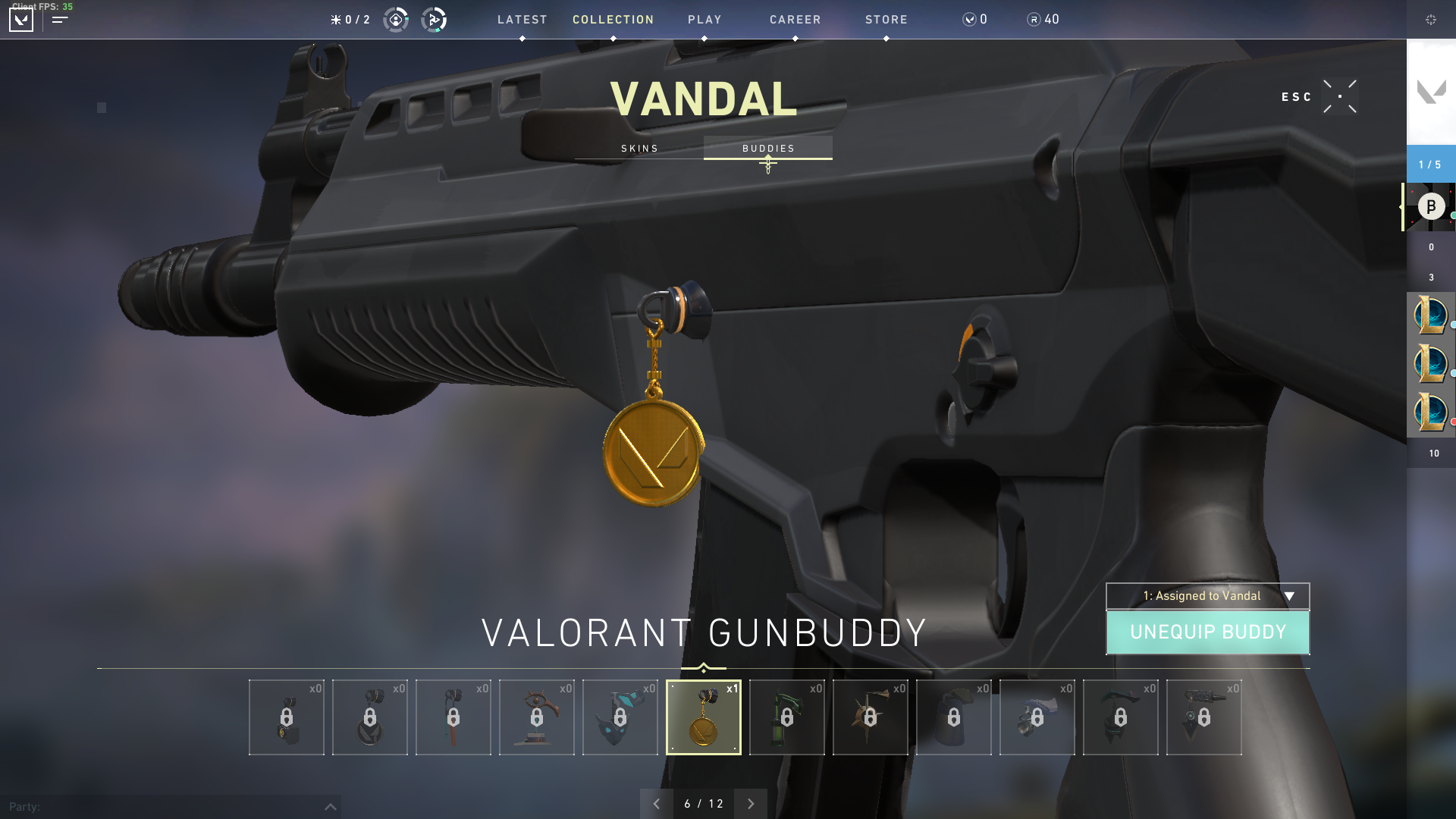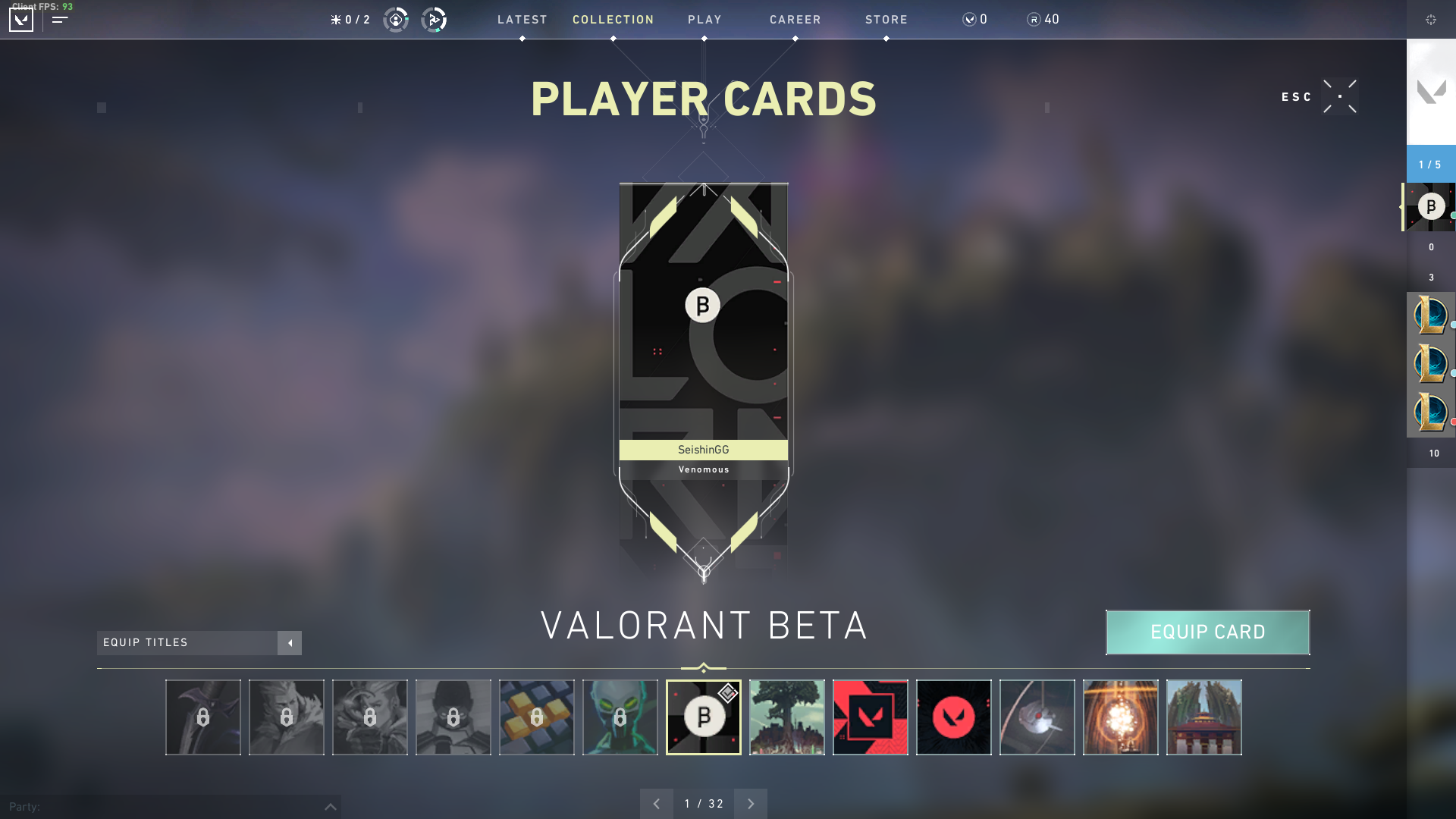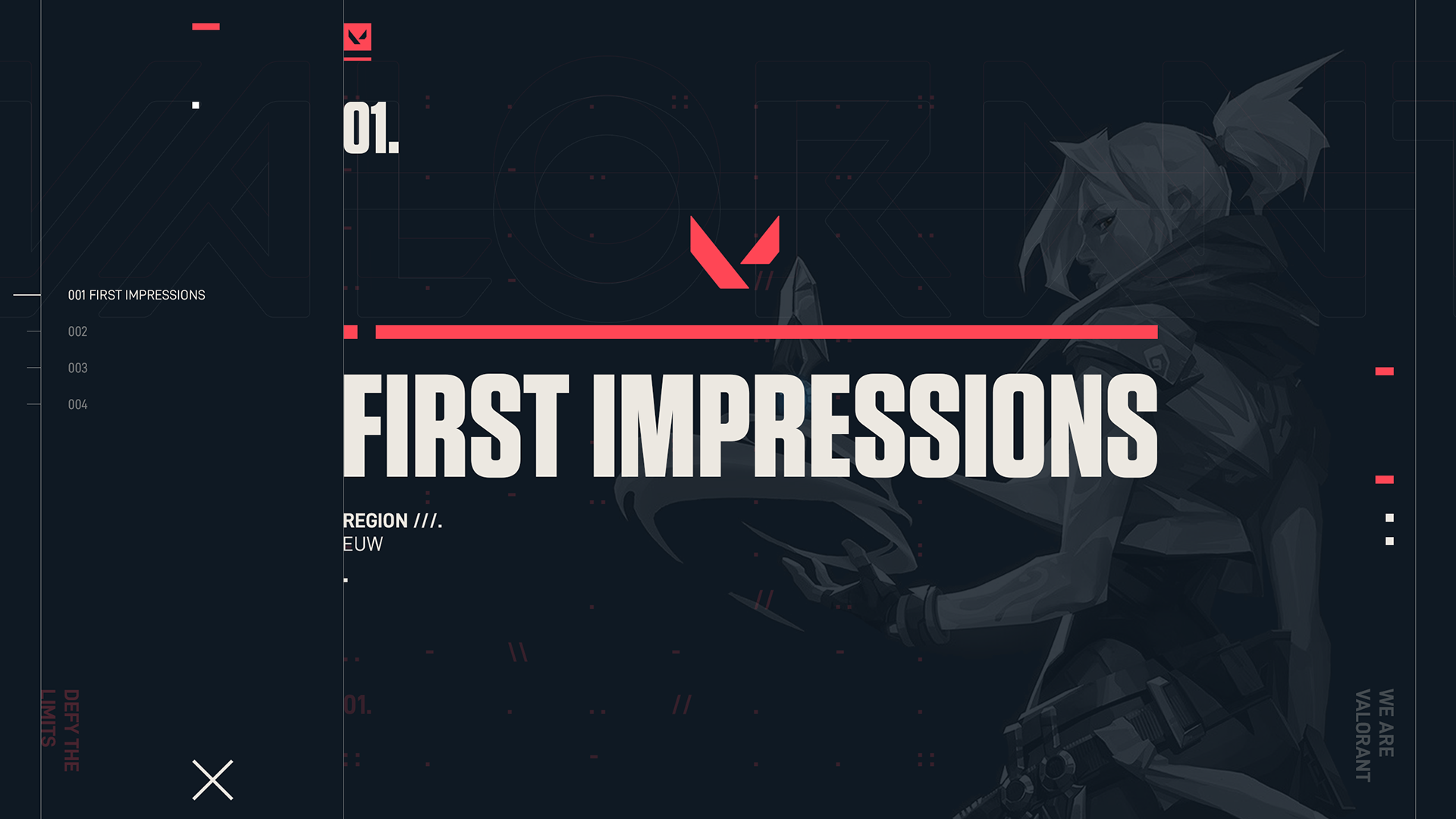
First Impressions: VALORANT
Is Riot Games latest title on the path to be crowned the new king of competitive FPS?
JOHN NICHOLS
APRIL 17, 2020
VALORANT, the next major title from Riot Games after their genre-defining MOBA League of Legends released all the way back in 2009(!), entered its closed beta on April 7th. Hundreds of thousands, if not millions, of viewers flocked to Twitch in their hopes of bagging exclusive access, and as luck would have it (thank you summit1g!), I got access on the evening of April 8th.

On the first day of the closed beta, VALORANT reached the second-highest concurrent viewership for a game on Twitch, bot-views not withstanding. Considering the other titles at the top of this list (League of Legends at #1 and Fortnite at #3) got their figures during huge esport events, two points are clear; VALORANT’s hype is unmatched to any esport-worthy release in at least the last five years (potentially barring Fornite), and Riot’s method of distributing access to the game was a fantastic marketing move.
To get access to the game, you have to link your Riot account to Twitch and then watch any VALORANT streamer on the platform. This enters you into a pool of eligible accounts, of which Riot randomly selects accounts periodically to receive access. This has done two things – it has got highly-anticipated players to watch hour upon hour of gameplay, serving to increase their hype, and it has exposed the game to the wider Twitch audience who may not have heard, or cared, about VALORANT beforehand. Even 10 days after the closed beta launch, many streamers are still attracting much higher than average viewerships as gamers scramble to obtain access.
Ever since Riot first announced the then-titled ‘Project A’ in October 2019, I fell head-first into the hype train. When a studio has spent over 10 years working solely on a single title, branching out is a huge deal (let alone into a new genre), and it was clear that Riot were not about to do things in halves. I was over the moon when I received access, so let’s dive right in and see how the game currently stacks up.
Home Screen, Graphics & Settings
Following a short tutorial which introduces you to the basics of the game, you’ll arrive at the home screen.
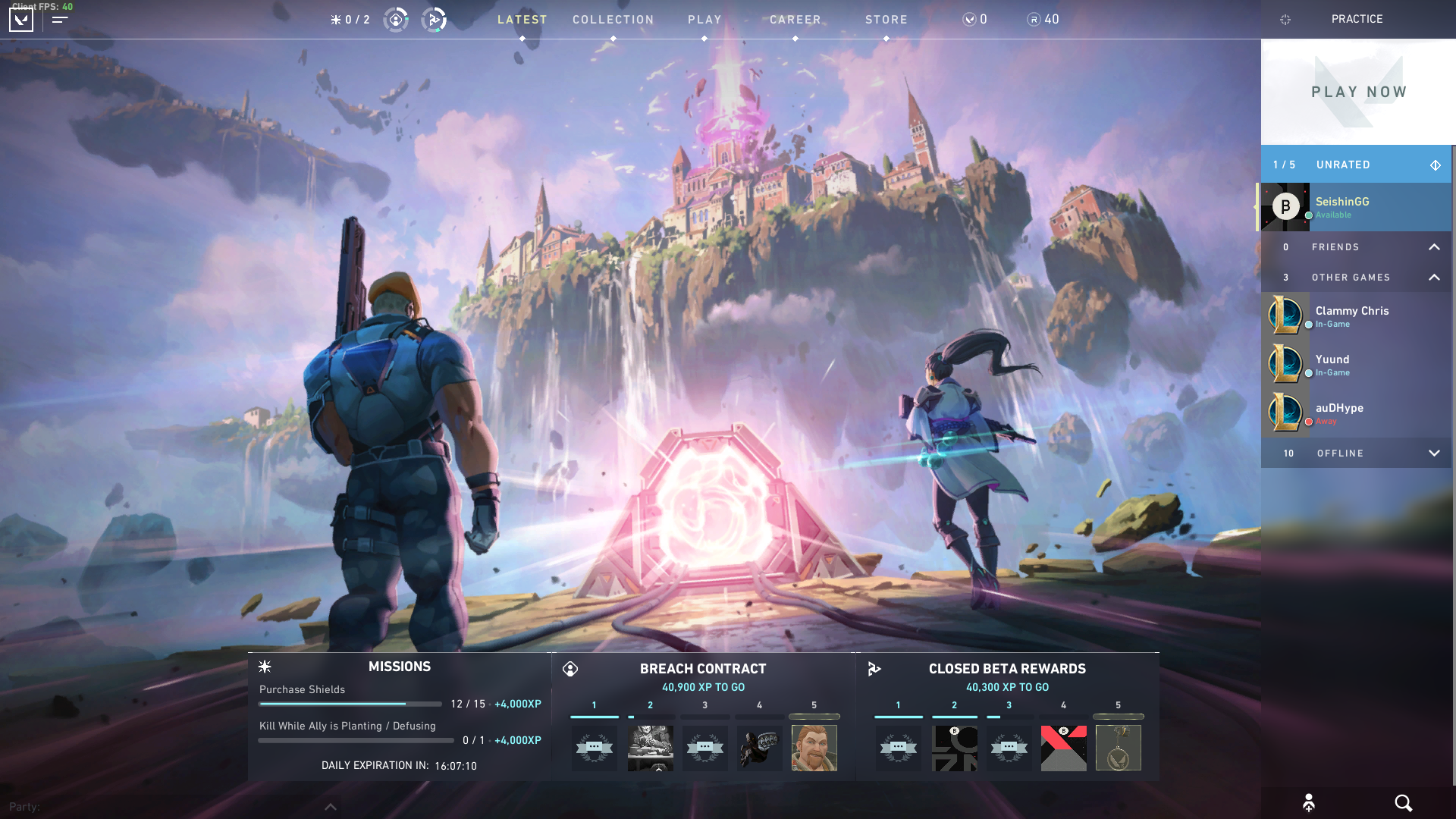
Here you can see the current progress towards your daily missions on the bottom-left, as well as your current breach contract and closed beta progress. Contracts are a long-term missions which unlocks titles, sprays, avatars and more related to a specific agent (character). As you’ll typically receive between 3,000 to 4,000 exp per match, these take a long time to complete.
You can also see a friends list on the right-hand side. It’s interesting to see that this appears to sync across Riot’s other titles, meaning you can message friends in both League of Legends and Legends of Runeterra.
In terms of the graphics, the art direction is fantastic. It’s a heady mix of realism and fantasy – think inbetween CS:GO and Overwatch. It looks quintessentially ‘Riot’, in that it strikes a brilliant balance between visual eye candy and cleanliness, perfect for both players and viewers alike.

The agents, environments and effects are very stylised, whilst the weapons themselves are in a neo-realism style that serves to compliment the competitive nature of the game. The general art direction and style has clearly been developed with spectators in mind, which makes it easy for fans to pick out the nuances whilst also make it easier for the casual viewer to understand what is happening on screen.
As it stands, there’s currently a rather rudimentary set of video setting options, with simple high-medium-low or on/off settings for most choices.
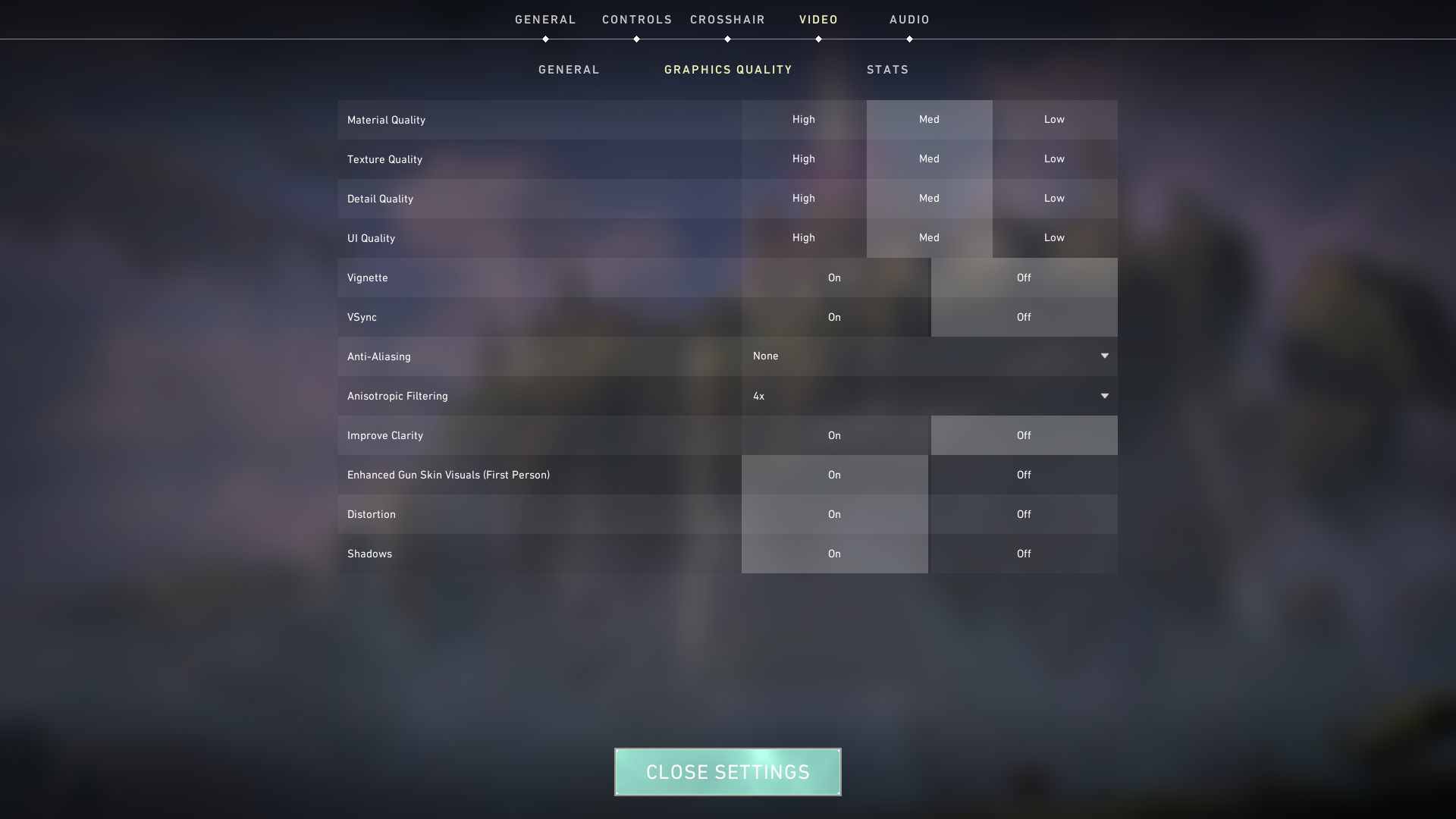
As a competitive first-person shooter (FPS), frame-rate is important to VALORANT, and Riot have made clear that they want the game to run well on machines several years old. I have tried running the game on the lowest possible settings on my 8-year old laptop and received a rather erratic low framerate, bouncing as high as 60 and as low as 15 depending on screen action, but for a machine that old, that’s fairly impressive. The game runs perfectly well on my mid-spec gaming PC, easily averaging 140+ FPS on medium settings, and so if you have a relatively modern machine, you shouldn’t have any difficultly hitting that essential constant 60 FPS.
Concerning in-game options, it is great to see that VALORANT already has support for custom keybinds, however many players are already calling for the capacity to customize keybinds for each agent. Since there isn’t a common theme in what ‘ability 1’, ‘ability 2’ etc. do between agents, this is a much-needed feature!

Two options which are currently missing are a left-handed gun-hold, and infinite scroll-wheel weapon switching, though with this only being a closed beta, it’s understandable that these minor features are yet to be included. I do hope we’ll see them in future!
The level of crosshair customisation is a definite strong point. Getting your crosshair to look exactly how you want it to is something that many FPS players obsess over, and VALORANT features a plethora of options, alongside a handy preview window.
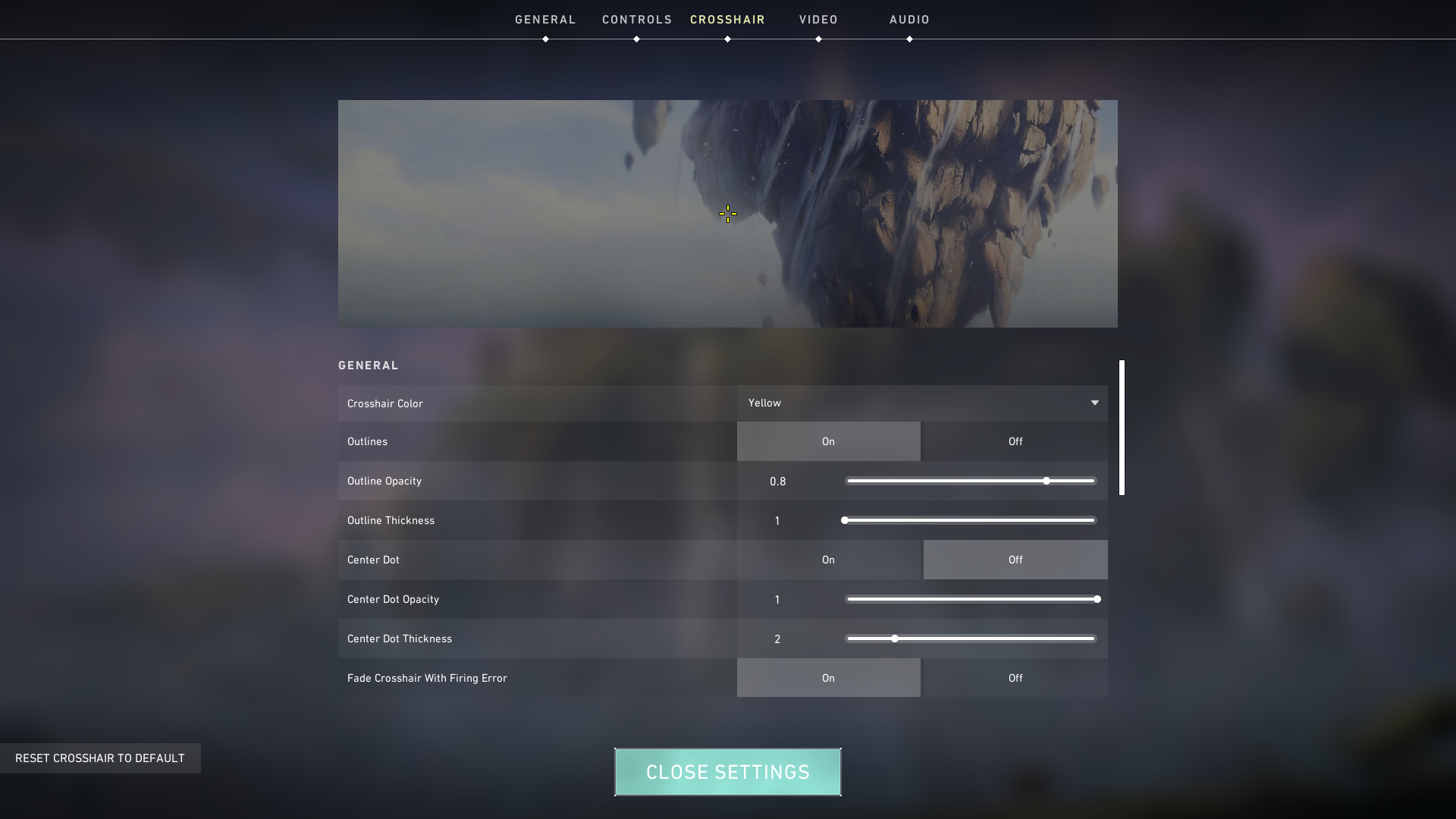
Size, thickness, opacity – the only option missing (which sorely needs to be added) is an RGB colour picker, which I hope is on its way. The ability to edit your crosshair both inside and outside a match is also a welcome addition, meaning that changes can quickly be made on the fly.
Storefront
Being a free-to-play title, VALORANT has a variety of cosmetic micro-transaction options. These primarily take the form of weapon skins, which can be purchased through a rotating skin shop, akin to Fortnite. As skins in VALORANT are often complete remodels rather than just reskins as in CS:GO, it is likely that instead of going the community-driven skin route, VALORANT may opt to go for marketing crossovers, similar to how Fornite has collaborated with everyone from Marvel and the NFL to John Wick and Nike, although this is just a hunch.

Any skins purchased during the closed beta will be exchanged for 120% of their value in in-game currency on its full release. With skin prices being as high as they are, this is a welcome gesture, and based on the number of players with skins I have encountered so far, it’s clearly been a success for Riot thus far. Are the prices too high? I think they are, but with plenty of players having already purchased skins, I can’t see Riot lowering them any time soon.
There’s one aspect of the store in particular which deluges a lot of information that I’ve not often seen discussed thus far.
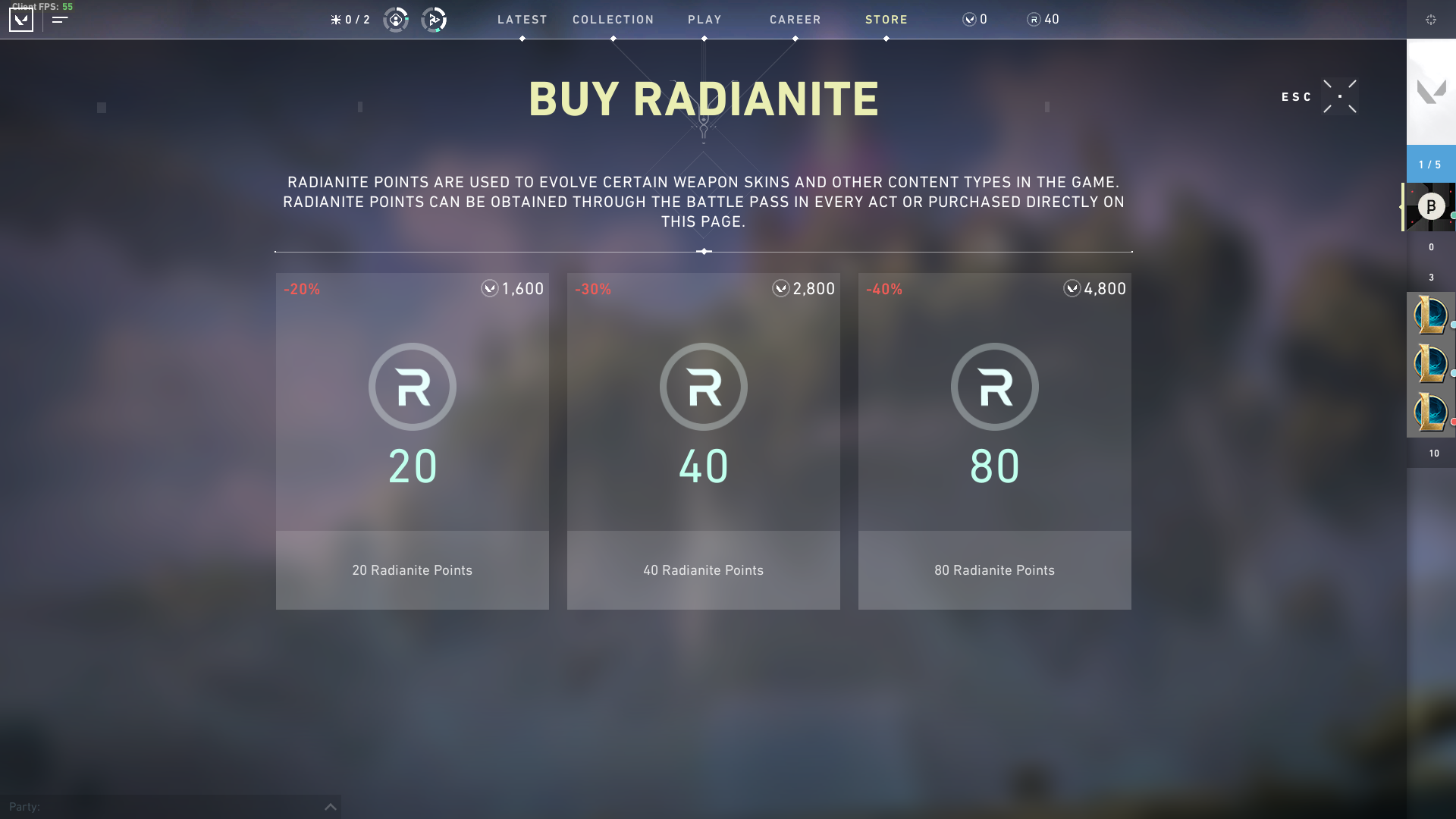
In the purchase menu for Radianite Points, an in-game currency which can be used to modify your weapon skins and other items, the text mentions both a Battle Pass and an Act system – clear evidence of gunning for a Fornite-esque life-cycle. Time will tell as to how this is implemented, but as current skin collections (e.g. the Reaver Collection above) are priced around £50.00, I am slightly worried as to the direction Riot will go price-wise for these passes, and whether or not they will present genuine value to the average player.
Customisation Options
Weapon skins aren’t the only form of customisation. Titles and player cards, which pop up on a player death, offer a Call of Duty-esque personalisation, whilst sprays give you a way to tag the map, akin to CS:GO and Overwatch. Gunbuddies are the biggest element however, which work in exactly the same way as in Blacklight: Retribution back in the day. These little trinkets hang off your gun near the trigger, giving your weapon a little personal distinction.
Alongside agent skins (which I believe haven’t been announced thus far but I strongly suspect are in the development plans), gunbuddies are the most likely way that VALORANT will collaborate with big brands, if the title goes the Fornite route of cross-promotion. Imagine a brand logo, mascot or Twitch emote appearing on your weapon – it would be an easy way for a player to show their appreciation. These would work especially well for esports organisations and streamers, and I can see them being akin to stickers in CS:GO.
Anti-Cheat System & Bans
Before we get into the gameplay itself, let’s look at Riot’s bespoke anti-cheat solution, Vanguard. It has recently been mired in controversy as despite prior announcement, some players are still cautious that part of the anti-cheat has kernel access and is loaded on system startup. Riot were quick to dismiss this as a necessary evil of sorts to combat cheaters, and insisted that Vanguard should have little impact on machine performance – time will tell if this is true, and if the community at large accepts this.
Riot have been cracking down hard on any suspected cheaters thus far, including banning a streamer live on stream, and numerous people (including myself) believe that Riot have a very tough challenge ahead in combating cheaters, especially as they’ve dogged plenty of recent FPS titles, including widespread usage in Call of Duty: Warzone, although it’s uplifting to hear that Riot are tackling this problem head-on and are keeping the community in the loop with any developments.
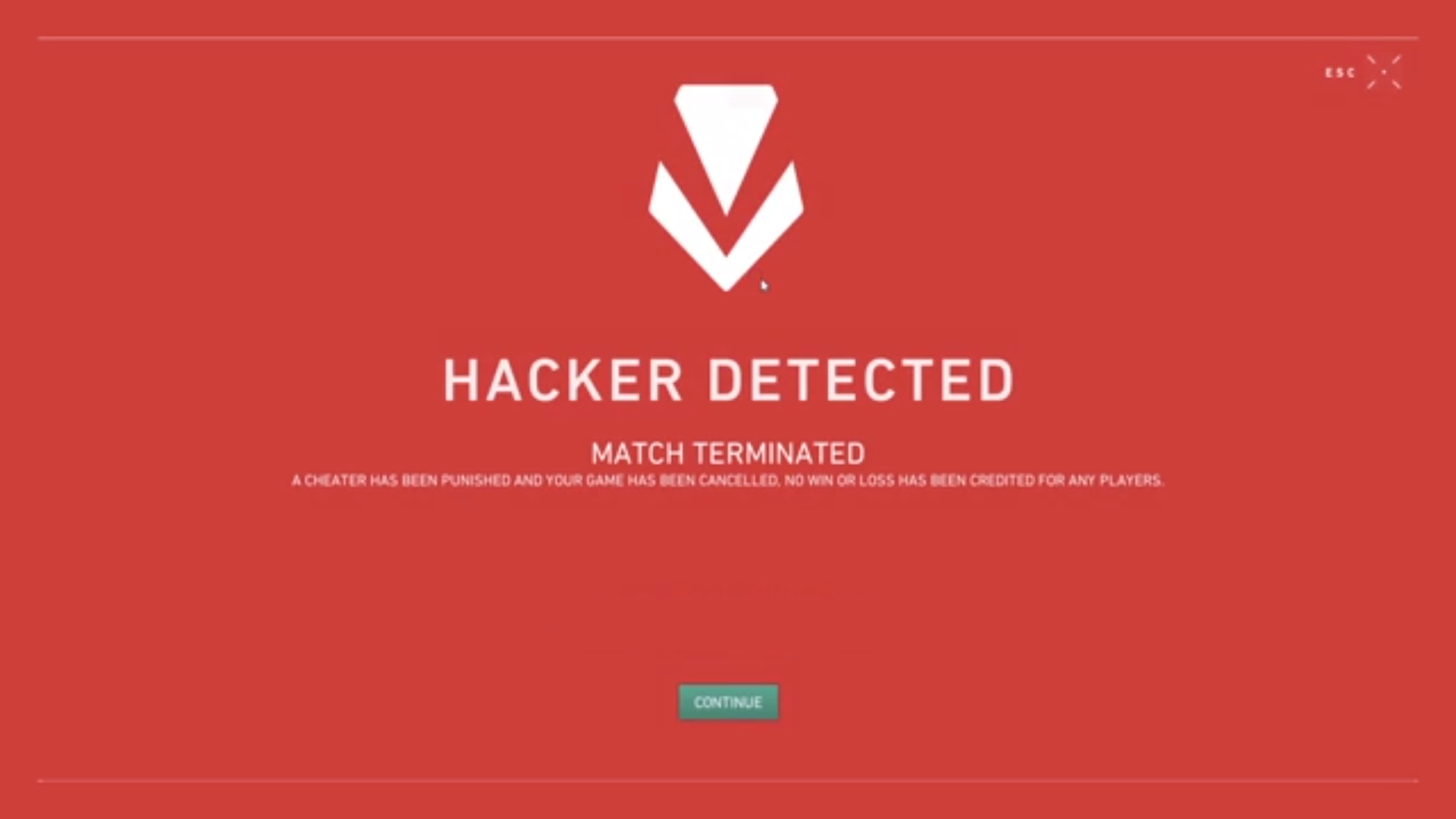
The hype around VALORANT’s closed beta has also lead to the unfortunate issue of account selling. Tying access to Twitch streamers has led to bots harvesting access-enabled accounts, which have then been sold at rather exorbitant prices. Riot has been very open with banning purchased accounts thus far, but it looks like this will dog the game until its release.
Match Format
The plant/defuse 5v5 gameplay is clearly inspired by Counter-Strike, but the agent/ability aspect shows both a League of Legends and Overwatch influence. Rather than having a standard attacker/defender character, you can choose a unique agent in the pre-game lobby, which each specialising in a different area, whether that be map control, vision, healing or otherwise. Each agent has four abilities; one signature ability which is free-of-charge, two abilities which are paid-for through the match economy, and an ultimate, which requires filling your ultimate point bar. Points can be gathered around the map, or are given for kills, defuses and other key in-game actions.
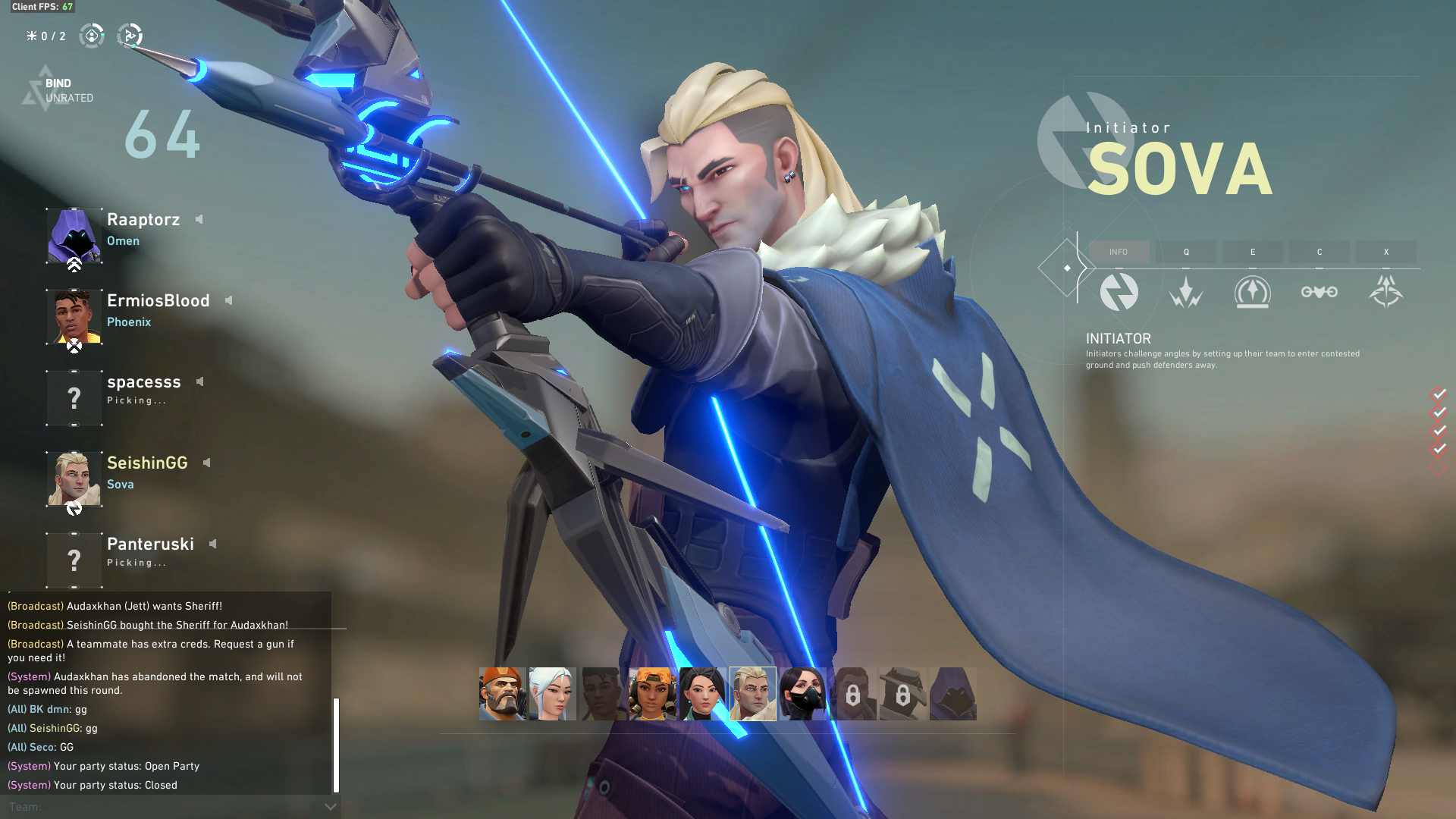
Matches are conducted in a best-of-25 format (first to 13) split into two halves, with the attacking/defending sides switching at round 13. Each round consists of a 30-second buy phase (45 for the first round of each half, and for round 25) and a 100 second game clock, or until the spike detonates. As there is no pre-game warm-up, an average match (in my experience) takes around 30-40 minutes, with a close match approaching the 50-minute mark, which strikes a good balance between the sub-30 minute competitive matches in Overwatch and the often 60+ minute matches in CS:GO.
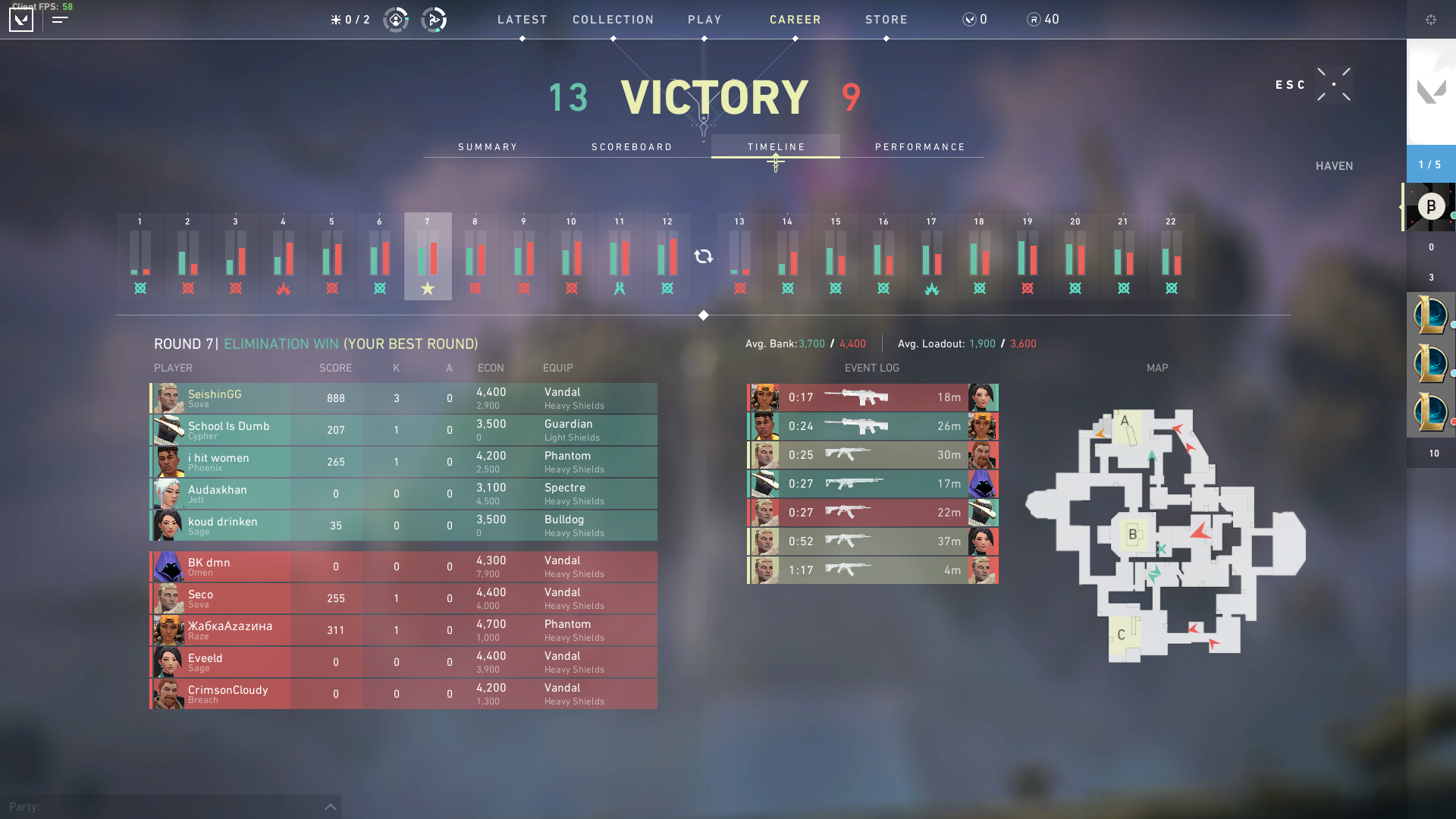
The economy works in the standard competitive FPS format. You get money for a kill, assist or spike (bomb) plant, and of course a round-win bonus, ‘successive loss’ bonus, and a bonus for any missing teammates. Each half starts with a ‘pistol-round’, and the economy swings back and forth from there.
Gameplay
How an FPS game ‘feels’ is difficult to put into words. The best way I can describe it is how each aspect of the game comes together to create a cohesive, competitive experience, and it is this which any FPS title hangs its success on.
Gunplay
The gunplay feels solid and weighty, if not a little more forgiving than CS:GO. Each weapon has a general spray pattern which can be memorised and compensated for, and for the most part, you never feel hard done by when an enemy kills you. There have been very few situations thus far where I feel that the game itself, whether that be server tick-rate, hitboxes or otherwise, has affected my standard of play, minus a few minor sound issues and a few questionable wallbang spots.
Abilities
In general, the abilities of each agent appears to be evenly balanced, other than an interesting Cypher bug (now patched out) and a particular ultimate ability. There has been a lot of uproar concerning Raze’s ultimate – a single-shot rocket launcher which can easily kill all five members of a team should they be stood close enough. There’s been plenty of debate not just between streamers, but also on social media about whether the ability is overpowered, and whilst I can see the arguments both ways, I’d be very surprised if the game releases with Raze’s ultimate in its current form.
As more agents are added, it will become increasingly difficult to keep the abilities balanced, and I believe it will be much more tricky to balance VALORANT that the ‘change a few numbers’ approach in League of Legends.
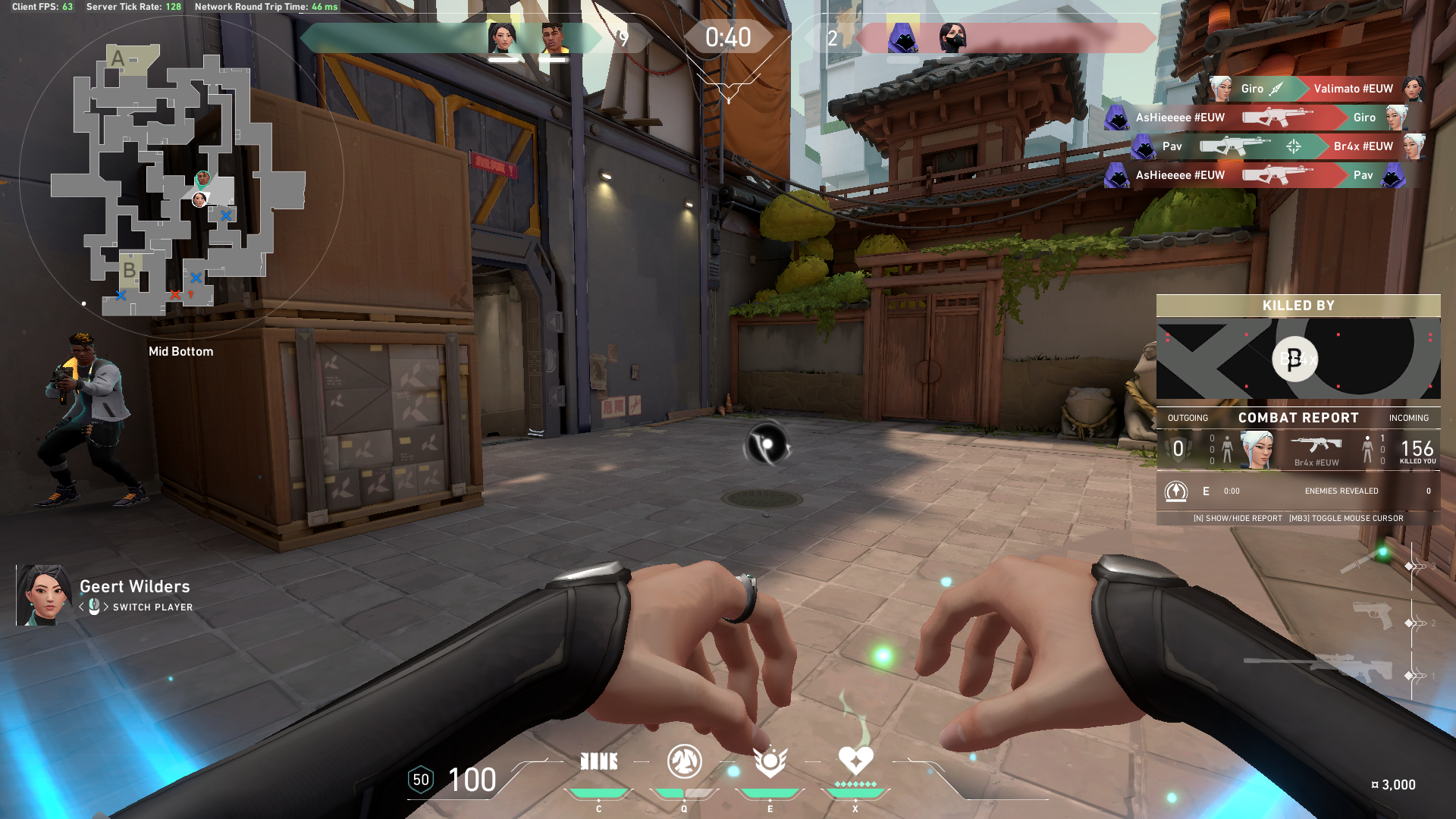
Movement
Movement feels fluid and intentional. The clean environment design means there’s very little friction between where you want to go and where the game allows you to, and as of yet, I’ve not encountered any surprises with movement on any of the three maps. With agents like Jett, Omen and Raze offering more vertical movement options, there’s plenty of tactical variety which Riot has carefully designed across each map, and the vertical movement is very satisfying to execute in all instances.
The movement penalty system for getting shot is quite major, but to me, this is a welcome addition. It promotes proper checking of angles, as well as highlighting the use of your abilities to scout areas, as opposed to the ‘corner-peeking’ standard in CS:GO.
Sound Design & Communication
In terms of sound design, I have very few qualms. There is the odd situation where it can be difficult to pinpoint by ear exactly where footsteps are coming from, but for the most part, sounds are clear, precise and offer up all the additional imformation a competitive player would want. The dialogue from the agents really shows their individual personalities, often times humourous, but also often recognising the importance, lore-wise, of the match taking place.
The voice communication software is clear, and I’ve never had any issues using it thus far. Speaking of communication, having clearly taken inspiration from their ping system in League of Legends, Riot have also implemented a rather fantastic ping system in VALORANT. Alongside standard pings for ‘danger’, ‘help me’ and the like, there’s also a ‘timed ping’. These count down automatically to signal when to initiate a push or rotate across the map, and are a fantastic way to communicate with your team if all members don’t have a mic.
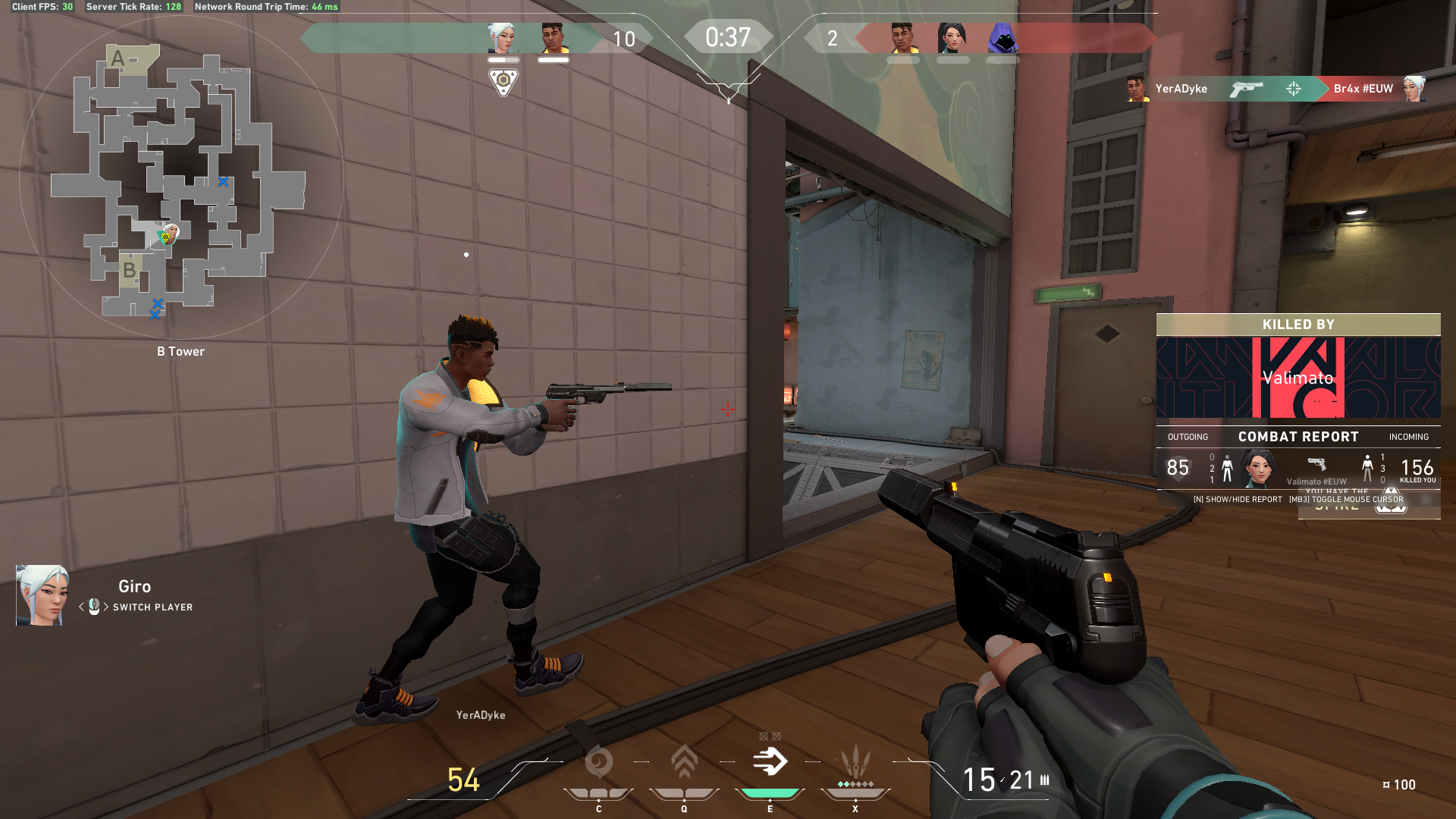
Balancing
To try and even out matches in which a player has poor connection or leaves entirely, VALORANT has a well-thought out disconnect balancing system. Should a player encounter connection issues, the game will automatically pause at the start of the next round to give this player a chance to reconnect. Should this player not reconnect in time, a free ult orb, giving a single ult point, will appear at the spawn point of the disadvantaged team each round, giving them a small advantage moving forwards. Furthermore, if a player leaves the match entirely, each of their four remaining teammates will receive a free small armour (equivalent to 25hp) every round for the rest of the game. This system has kicked in a few times in my matches thus far, and it does a good job of evening the odds, neither falling too short nor going too far.
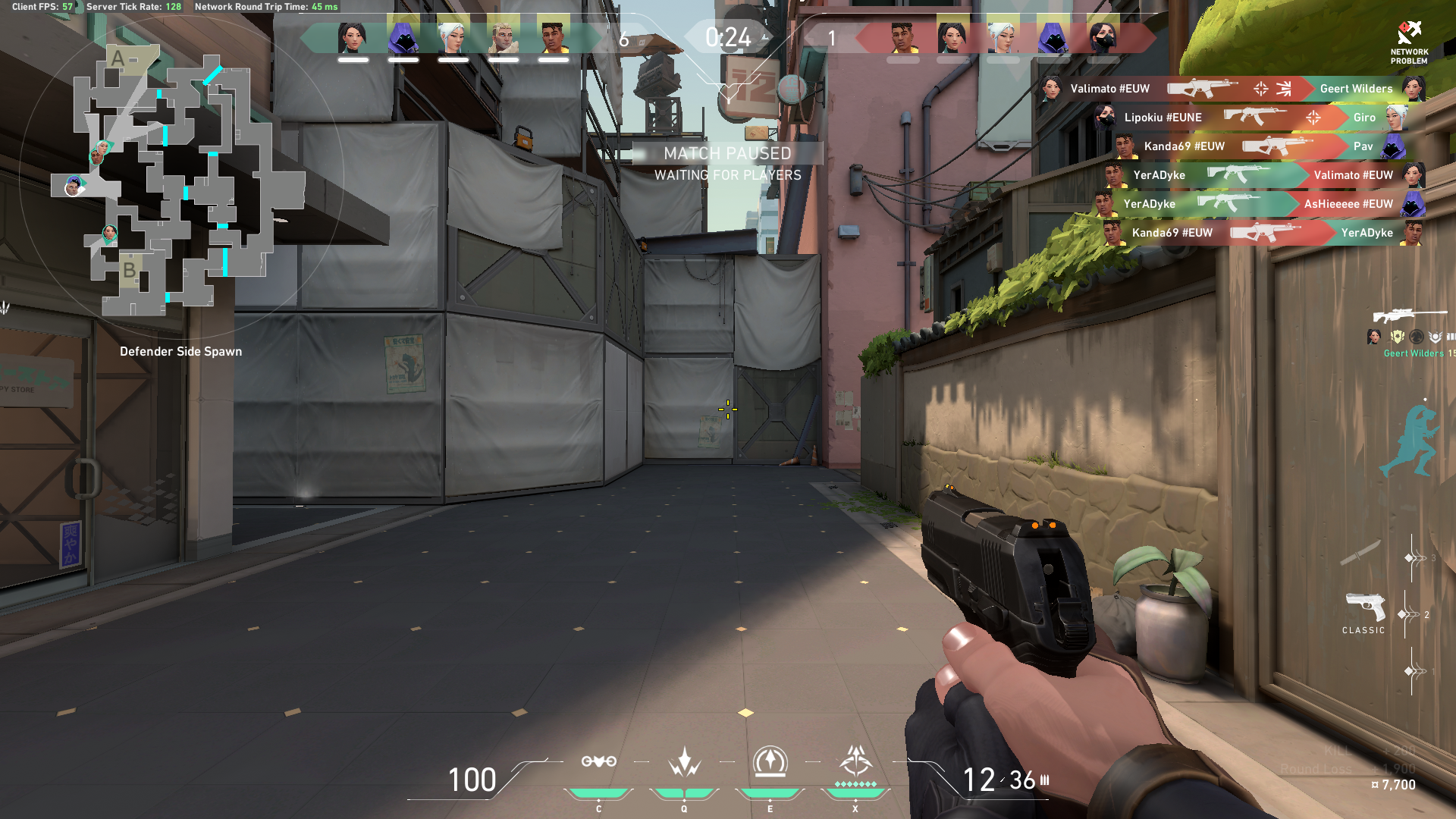
Riot has announced that prior to its full release, VALORANT will feature 12 agents and 4 maps. With Raze and Breach added at the launch of the closed beta, a potential new agent already data-mined, and hotfixes already occuring, Riot looks prepared to patch the game on a regular basis to maintain its competitive integrity. Thus far, they have been very open with the player base, being active on both Reddit and Twitter, openly discussing balancing issues, suggestions from players and upcoming content.
Maps
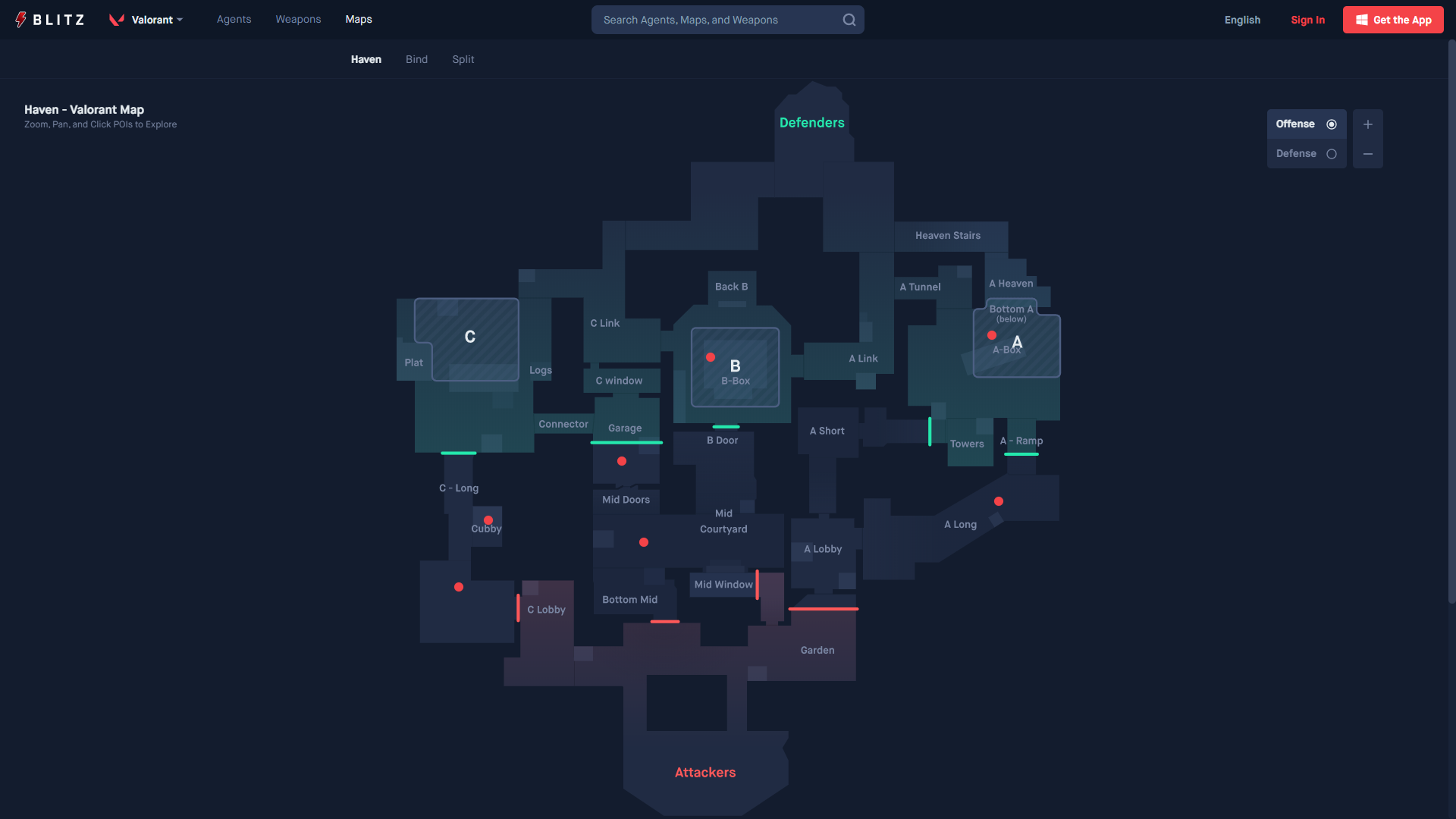
Haven is the most unusual of the three, as it features three bomb sites as opposed to the usual two. As its code-name Triad suggests, it’s has a beautiful Chinese theme, with traditional architecture aplenty. Sites A and C play fairly similar – both have a short and a long attacking route, with Site A featuring a window position (Heaven), and Site C a back-of-site cubby spot (Plat), popular with snipers. Site B is manic – with three entrances and its central position, it’s often difficult to take and even more difficult to hold. The three-site style is usual but works well – there’s numerous paths for rotations and a good mixture of short, medium and long-range gunplay.
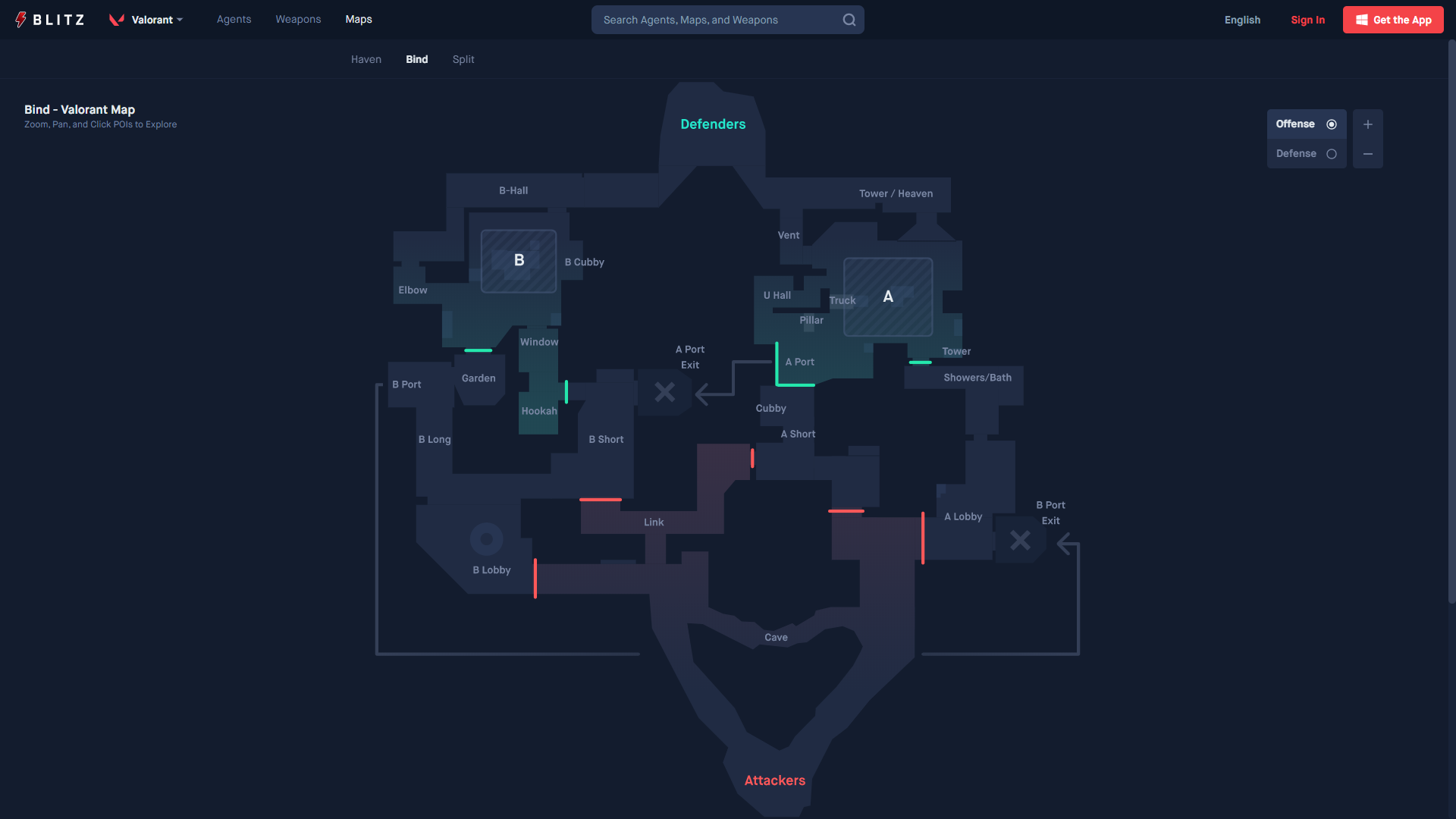
Bind is a traditional, medium-sized two-site map, with an aesthetic comparable to that of de_dust and de_dust2 in CS:GO. It’s unique feature is two one-way portals, one connecting Short A to Short B, and one connecting Long B to Lobby A. These serve clear audio cues when used, and are efficiently balanced through the use of one-way doors at each exit side. Bind plays very much like a CS:GO map, with clearly defined paths to each site and a hotly-contested middle area, and if you’ve come from CS:GO or Rainbow Six Siege, it’s likely to quickly become one of your favourites.
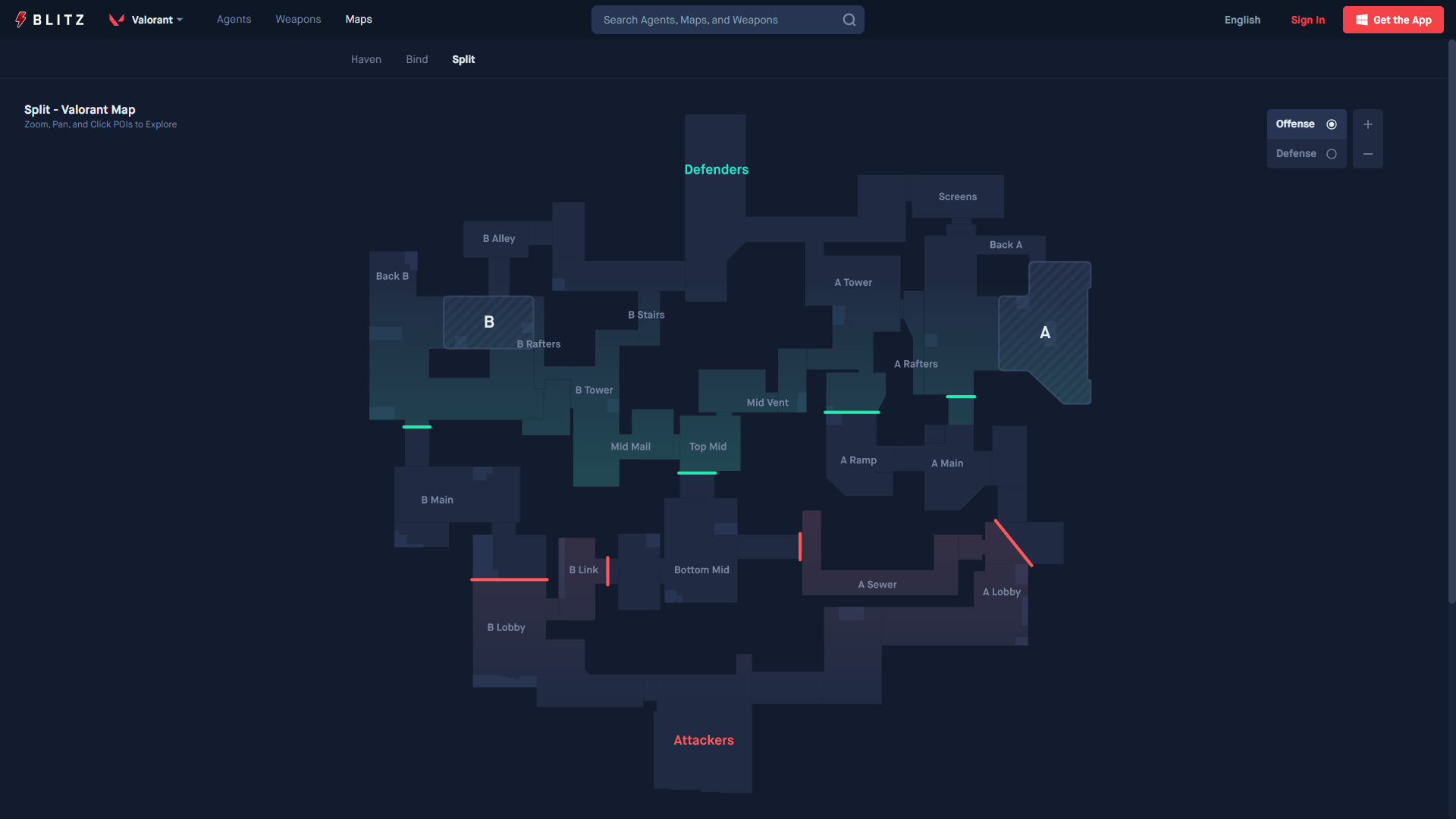
Split is a classic ‘control the high ground’ map, with long rotation paths, plenty of short and medium-distance gunplay and a lot of flanking opportunities. It’s industrial styling lends into its right-hand corner heavy design, and with an abundance of small rooms and loud floor materials, this is the one map where a good pair of headphones will give you a clear advantage. Both sites feature vertical map-play and plenty of entrance/exit options for attackers/defenders.
Right now, Split appears to be the most ‘defender-sided’ map, akin to pre-2016 de_nuke in CS:GO. It’s combination of quick defensive rotation paths, defensive high-ground and choke points makes attacking either site very difficult against a well-prepared team. Agent abilities really shine here, as only through their skilful use will a team come out on top.
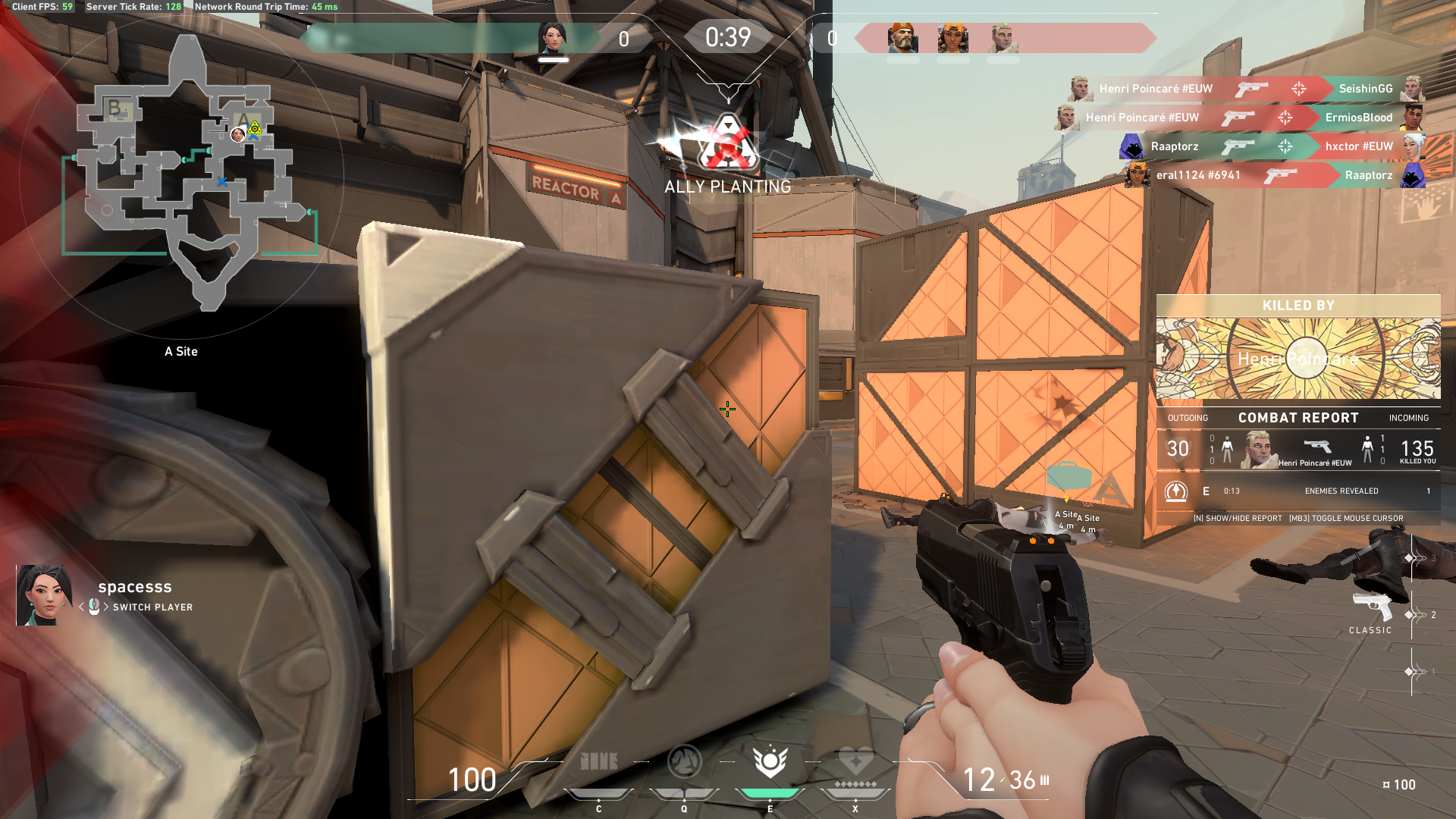
Unusually, the general consensus is that Haven, despite its 3-site design, is the most balanced map thus far. Site B is incredibly difficult to both enter and defend, but Sites A and C appear to be roughly evenly matched for both sides. Haven is definitely my favourite map at the moment, as the sheer variety of attacking and defending options the 3-site design gives you means there’s plenty of room for a wide range of tactics, with no two rounds being the same.
A fourth map, Ascent, was data-mined earlier this week. Prior to the leak, Riot had announced that a fourth map would be added to the game prior to release, and it’s highly speculated that this will be Ascent. It is rumoured to feature an Venetian aesthetic, with the map name possibly referring to a floating island setting – a sneak peak of which we may have seen in a developer video early this week.
Lore
Very little is known about VALORANT’s lore at the moment, but looking at the extensive, detailed lore of League of Legends, we can fully expect Riot to invest substantial resources to flesh out just exactly what we’re doing in our matches.
From what we know so far, VALORANT is set in a near-future version of Earth, sometime after an event called the First Light. All we know about this event thus far is that it transformed daily life, and caused certain people around the world to gain abilities. These people would be known as Radiants.
An organisation titled the VALORANT protocol is set up as a result, pulling together both Radiants and those equipped with similar technology. From current agent audio samples, it appears some of the current Agents have crossed paths before, as they often have dialogue amongst each other during the buy phase of each round. I have mostly been playing Sova throughout the closed beta, and I’ve heard quirky lines of dialogue with both Phoenix and Sage on the same team.
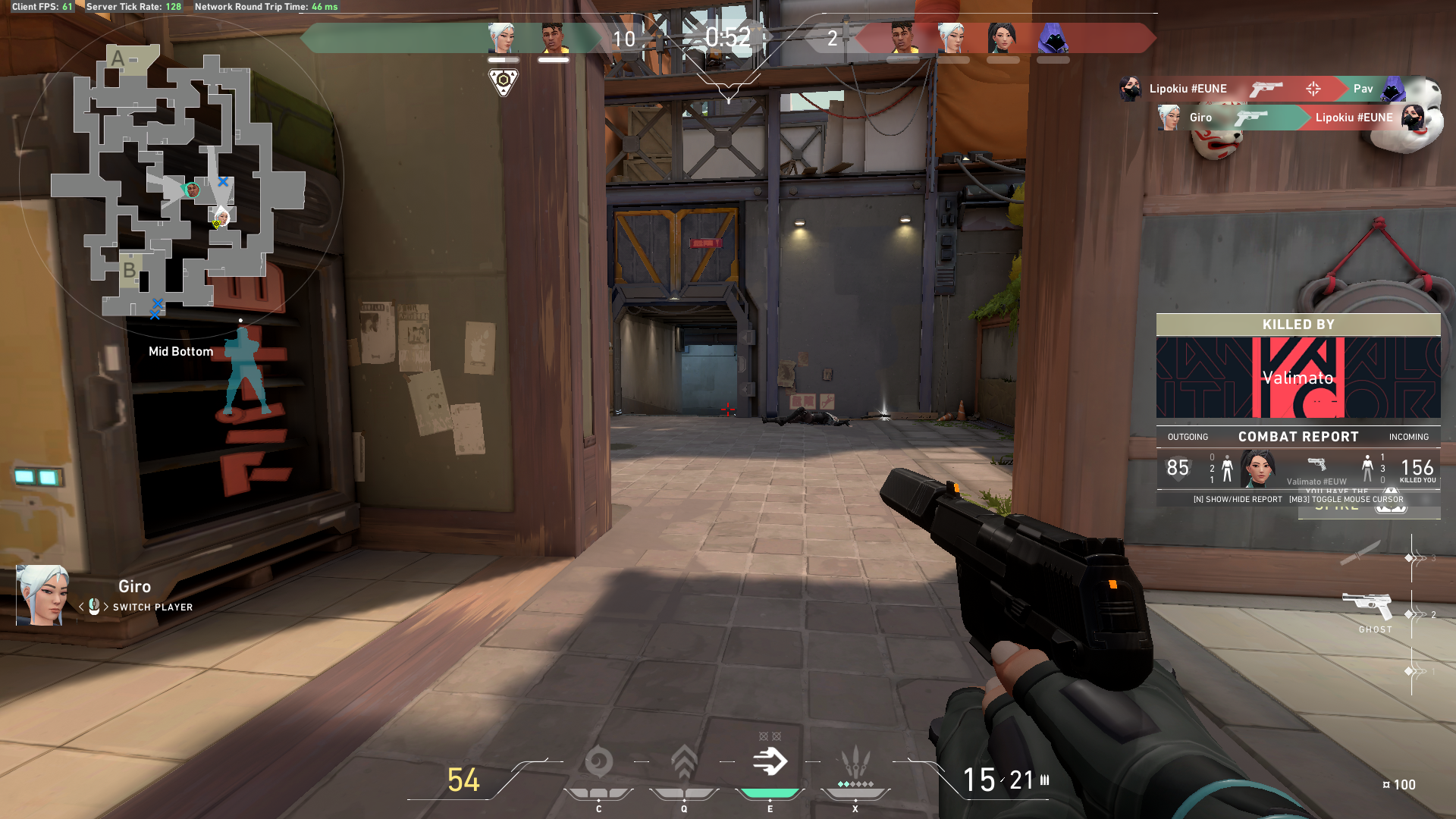
Riot’s Creative Director, David Nottingham, said in an interview with the YouTube chanlle Qwixzo that they will being going for an “environmental storytelling” approach to the lore, letting the maps, dialogue and character interactions tell the story. If Riot turns their video production department towards lore-intensive videos for VALORANT however, we will be in for a treat, judging from their past successes with League of Legends. From Amumu to Jinx to Annie and many, many more, Riot have consistently knocked it out of the park with their cinematic content, and I would be very surprised if we didn’t see at least a few lore-focused cinematics for this new IP.
Wrapping Up
It is clear that, with VALORANT, Riot Games aren’t just aiming to add another competitive FPS to the already inflated market. With the level of investment and preparation it takes to commit to a whole new genre, they are aiming for nothing less than to take the esports crown from Counter-Strike, which has sat on the FPS throne for the best part of the last 20 years. Indeed, Whalen “Magus” Rozelle yesterday (Riot’s Senior Director of Global Esports), posted yesterday that players may be hoping to compete in VALORANT’s ecosystem “ten, twenty, thirty years from now”, so it’s clear that Riot really are in this for the long run.

Riot are hedging their bets that 128-tick servers will bring pro players and streamers alike flooding in, and, at least at the moment, it appears to be working. With esports organisation 100 Thieves having already held an exhibition invitational, and with the announcement that a ranked ladder will be added during the closed beta phase, the hype for VALORANT, both among pros and the general player base, won’t be dying down any time soon.
VALORANT may only have been in closed beta for 10 days, but a raft of esports heavyweights have already been signed, including infamous former iBUYPOWER CS:GO pros Brax and AZK, who both signed for T1. TenZ signing for Cloud9 on April 16th signalled their entrance into VALORANT esports, POACH is likely to move from Fortnite to VALORANT with Team Liquid, and Vanguard and Ninjas in Pyjamas are among many organisations to have also made moves. With Riot announcing the guidelines for VALORANT esports events yesterday (April 16th), it’s likely that it will not be too long before we see the formation of a regular schedule of events at the highest level.
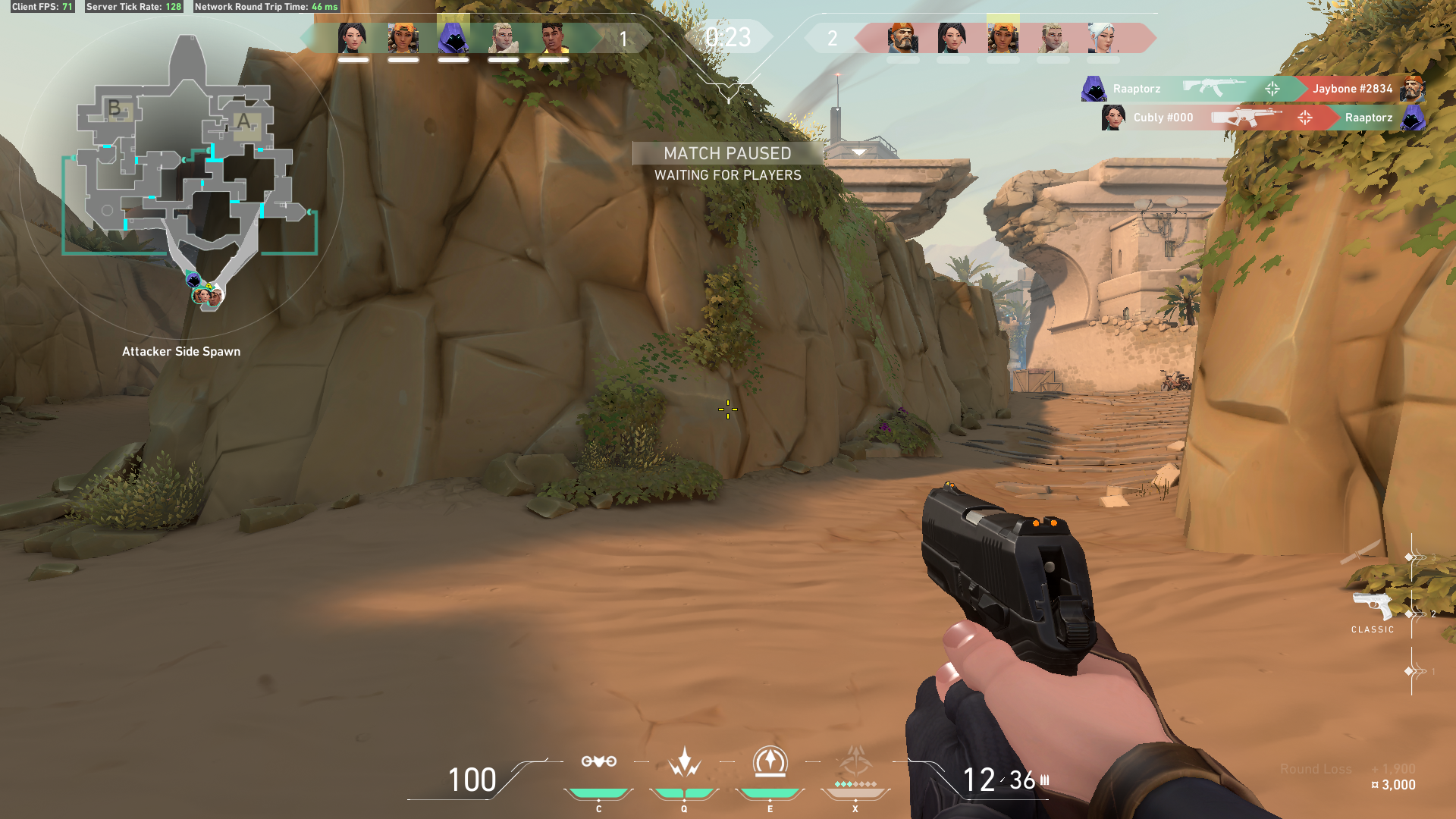
Having been a big fan of CS:GO for many years, I was skeptical that Riot would be able to produce a solid title that could match it’s level of hype and adoration, both at the pro and casual level. From what I’ve both seen and played of VALORANT so far, it has far surpassed my expectations, and I really do hope that it can go from strength to strength from here. To take CS:GO’s crown is a huge ask, but do I believe VALORANT can do it? If they keep up the level of community interaction, game development and support into the competitive scene, I certainly think they can.
Though we’re in the very early stages, VALORANT is a title with the potential to be a mainstay for many years to come. Riot has found the formula for the next massive player in esports, and if they convert their strong start into further progress in the coming weeks and months, they will surely be on to a real winner.
Published April 17, 2020.
